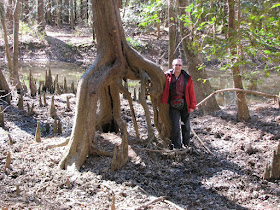There's nothing that I enjoy so much as hiking cross country in a very old forest. They make you feel very small, which is a good thing, lest we think too highly of our insignificant little selves.








 A whole day, twelve miles of hiking among the forest giants of Congaree National Park. It was a great experience. If time affords, I'll go back this year, before warm weather hits, and find some more of the champion trees I missed on that Saturday hike in the cold weather of a welcome winter chill.
A whole day, twelve miles of hiking among the forest giants of Congaree National Park. It was a great experience. If time affords, I'll go back this year, before warm weather hits, and find some more of the champion trees I missed on that Saturday hike in the cold weather of a welcome winter chill.









































